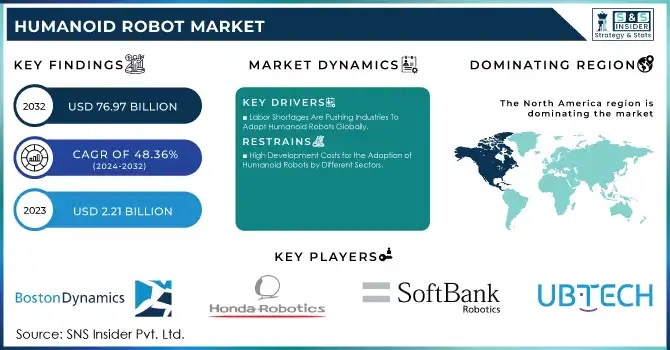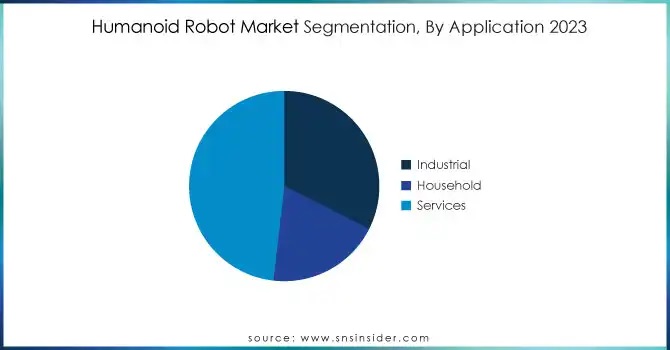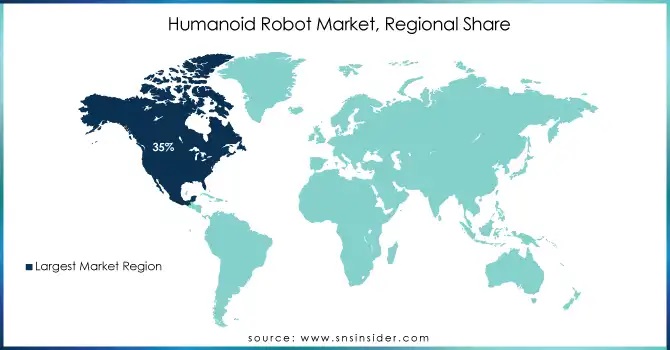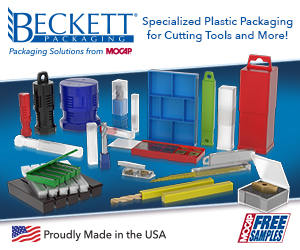
The Humanoid Robot Market Size was valued at $2.21 billion in 2023 and is expected to reach $76.97 billion by 2032 and grow at a CAGR of 48.36% over the forecast period 2024-2032, According to analysis by the SNS Insider.
The Humanoid Robot Market is witnessing transformative growth as there are technological advancements and the supportive policies of key nations. In 2023 and 2024, humanoid robots have moved from experimental prototypes to pragmatic solutions in industries ranging from healthcare to manufacturing.
Governments of such countries as Japan and China play a vital role in the market by providing large sums of funding and other strategic initiatives. Japan, known for its aging population, has used government-backed programs to deploy elder care robots. China's "Made in China 2025" strategy has focused on robotics to enhance industrial automation. The USA has invested significantly in robotics for defense and healthcare applications, with agencies such as DARPA fostering innovation.
Technological developments in AI, machine learning, and sensor technologies have significantly improved the functionalities of humanoid robots. Now, these robots have much better adaptability, mobility, and interactive features. For instance, Tesla's Optimus robot was unveiled in 2023. It stands at 5'8", weighing 125-160 lbs., with 28 actuators to mimic human movement.

The robot is great at tasks such as manufacturing, logistics, and household tasks because it boasts 11-22 degrees of hand dexterity, eight cameras, and AI learning. On the other hand, India unveiled the Vyommitra robot, showing its use in space exploration. France and Germany also have developed their industrial humanoid robotics integrated with advanced systems to make efficiency and productivity in manufacturing possible.
The future of the Humanoid Robot Market holds an enormous prospect in the areas of elder care, disaster management, and logistics. These robots have become the vital answer to the global labor shortages and increased demand for automation. In 2023, humanoid robot installations increased by 25% worldwide, and the growth is going to continue in 2024 as well, according to the World Robotics Report. Humanoid robots will certainly become a part of vital technology in industries as advanced AI and robotics technologies are implemented.
Key drivers:
Labor Shortages Are Pushing Industries To Adopt Humanoid Robots Globally.
There is an increasing labor shortage in countries like Japan and Germany, which have over 28% of its population over 65 years, creating a serious gap in workforce. Humanoid robots will help fill such gaps in terms of work done that were originally by humans from assembling parts on the factory floor to logistics management.
The International Federation of Robotics has stated that industrial robot installations grew worldwide in 2023. With the rising workforce shortages, governments and companies are becoming increasingly urged to invest in robotic automation to ensure continuity of operations. This trend makes humanoid robots an integral part of the modern industrial ecosystem.
Growing Need For Healthcare Support Boosts Humanoid Robot Adoption Worldwide.
The healthcare sector is under pressure due to aging populations worldwide. Humanoid robots are gaining traction in elder care, rehabilitation, and patient monitoring. In Japan, robots like Robear are utilized in caregiving to assist elderly individuals with mobility and daily tasks. Similarly, a 2023 study by WHO highlights that 35% of elderly care facilities globally expressed interest in adopting robotics within the next five years. These robots automate routine tasks such that healthcare professionals can focus on critical care, thus enhancing service delivery and patient outcomes overall.
Restrain:
High Development Costs for the Adoption of Humanoid Robots by Different Sectors.
The development and deployment of humanoid robots require huge investments in the hardware, software, and R&D. Advanced technologies such as AI-driven vision systems, precision mechanics, and adaptive learning algorithms have a high cost of manufacture and integration.
For example, highly advanced humanoid robots, Boston Dynamics' Atlas, cost at least $150,000, making it inaccessible for small to mid-sized firms. Additionally, maintenance and updates come with recurring expenses, further discouraging users.
Research in 2023 revealed that more than 45% of the small-scale manufacturers in Europe have reported financial constraints as a main reason for not adopting robotics.
Although governments and private organizations provide grants, most funds go to large-scale corporations, which leave smaller businesses underserved.
The lack of standardized regulations on humanoid robots also complicates the cost-to-benefit evaluation for potential adopters. Addressing these challenges will require collaborative efforts from governments, industries, and technology providers to ensure affordability and accessibility for all market participants.

Humanoid robot market key segments
By motion
The Wheel Drive segment led in 2023 with a 63% market share due to its operational stability and lower cost compared to biped robots. Wheel-driven humanoids are heavily used in logistics, retail, and healthcare for their ability to navigate flat terrains effectively. For instance, robots such as Pepper and Relay are highly deployed for customer interaction and delivery tasks.
Looking ahead, the wheel drive segment is forecasted to grow at the fastest CAGR of 48.49% from the years 2024-2032. This would mainly be due to wheel-based navigation systems that advance as well as humanoid robots get increasingly adopted in the sectors of service-oriented industries. They face limitations on uneven terrains, but cost-effective as well as versatile, this remains a preferred choice of varied applications.
By application
Service segment led the Humanoid Robot Market, accounting for 48% of market share in 2023 due to wide usage in customer assistance, hospitality, and healthcare. Some popular service robots are SoftBank Robotics' Pepper, gaining popularity with interactive capabilities and efficient execution of repetitive tasks.
The industrial segment is expected to grow with the fastest CAGR of 49.09% from 2024 to 2032. More industries are opting for humanoid robots to perform welding, assembly, and quality control, among others. For example, companies like FANUC and ABB are incorporating humanoid robots in their production lines to maximize productivity and minimize labor costs. The growing need for automation in manufacturing and logistics would drive substantial growth in the industrial segment, complementing the dominance of service robots.
Humanoid robot market reginal analysis
In 2023, North America dominated the Humanoid Robot Market share by 35%, driven by technological advancements, high adoption rates in healthcare and logistics, and robust government support. USA has led the region with substantial investments in robotics for healthcare and defense.
Asia Pacific is expected to grow the fastest with a CAGR of 49.65% in the period from 2024 to 2032. Japan and China are leading the country in robotics innovation with more government support and strong base manufacturing. Elder care robot leadership in Japan and the industrial automation initiatives in China show prospects for growth in this region. 70% of all new robots deployed in 2023 were installed in Asia. China holds the top spot for installing industrial robots with 51% of the installations.
Contact Details
Related Glossary Terms
- flat ( screw flat)
flat ( screw flat)
Flat surface machined into the shank of a cutting tool for enhanced holding of the tool.
- industrial robot
industrial robot
Robot designed for industrial use. Primarily used as a material-handling device but also used for changing tools, assembling parts, and manipulating special tools and measuring devices. Depending on design, an industrial robot can be programmed to perform a task by means of a controller, or it can be “walked” through the required movements by utilizing a digitizing system that translates movements into commands that the robot can be “taught.” See robot; teaching pendant.
- quality assurance ( quality control)
quality assurance ( quality control)
Terms denoting a formal program for monitoring product quality. The denotations are the same, but QC typically connotes a more traditional postmachining inspection system, while QA implies a more comprehensive approach, with emphasis on “total quality,” broad quality principles, statistical process control and other statistical methods.
- robotics
robotics
Discipline involving self-actuating and self-operating devices. Robots frequently imitate human capabilities, including the ability to manipulate physical objects while evaluating and reacting appropriately to various stimuli. See industrial robot; robot.






